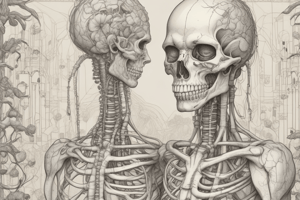Podcast
Questions and Answers
What is a primary characteristic of epithelial tissues?
What is a primary characteristic of epithelial tissues?
- They contain large amounts of extracellular substances.
- They always cover surfaces. (correct)
- They are not organized into layers.
- They primarily function in energy storage.
Which of the following types of epithelial tissue is specifically associated with absorption?
Which of the following types of epithelial tissue is specifically associated with absorption?
- Simple squamous epithelial tissue
- Compound squamous epithelial tissue
- Columnar epithelial tissue (correct)
- Ciliated epithelial tissue
Which connective tissue type is primarily responsible for energy storage?
Which connective tissue type is primarily responsible for energy storage?
- Reticular connective tissue
- Fibrous connective tissue
- Adipose connective tissue (correct)
- Elastic connective tissue
What distinguishes vascular connective tissue from other types?
What distinguishes vascular connective tissue from other types?
Which layer of epithelial tissue is characterized by multiple cell layers?
Which layer of epithelial tissue is characterized by multiple cell layers?
What is the primary function of elastic connective tissue?
What is the primary function of elastic connective tissue?
Which type of epithelial tissue lines the walls of the digestive system for protective purposes?
Which type of epithelial tissue lines the walls of the digestive system for protective purposes?
White blood cells are unique because they lack which component?
White blood cells are unique because they lack which component?
What is the normal range for white blood cell counts?
What is the normal range for white blood cell counts?
Which type of cartilage is primarily found in the trachea?
Which type of cartilage is primarily found in the trachea?
What is the primary function of red blood cells?
What is the primary function of red blood cells?
Which of the following is a characteristic of skeletal muscles?
Which of the following is a characteristic of skeletal muscles?
What is the function of platelets in the blood?
What is the function of platelets in the blood?
What condition may be indicated by a WBC count higher than 90000?
What condition may be indicated by a WBC count higher than 90000?
What is the main component of the smooth muscle tissue?
What is the main component of the smooth muscle tissue?
Which cells are produced in the bone marrow?
Which cells are produced in the bone marrow?
Flashcards
Epithelial Tissue
Epithelial Tissue
A tissue type that covers surfaces and rests on a basement membrane. It has few substances between the cells.
Simple Epithelial Tissue
Simple Epithelial Tissue
A single layer of cells forming an epithelial tissue.
Compound Epithelial Tissue
Compound Epithelial Tissue
Epithelial tissue consisting of more than one layer of cells.
Connective Tissue
Connective Tissue
Signup and view all the flashcards
Adipose Connective Tissue
Adipose Connective Tissue
Signup and view all the flashcards
Blood
Blood
Signup and view all the flashcards
Red Blood Cells (RBCs)
Red Blood Cells (RBCs)
Signup and view all the flashcards
White Blood Cells (WBCs)
White Blood Cells (WBCs)
Signup and view all the flashcards
WBC count and disease diagnosis
WBC count and disease diagnosis
Signup and view all the flashcards
RBC life cycle
RBC life cycle
Signup and view all the flashcards
Bone Function
Bone Function
Signup and view all the flashcards
Cartilage Types
Cartilage Types
Signup and view all the flashcards
Muscle Types
Muscle Types
Signup and view all the flashcards
Nervous Tissue Function
Nervous Tissue Function
Signup and view all the flashcards
Study Notes
Human Biology Overview
- Human biology studies the human body, including core building blocks (cells) progressing to tissues, organs, and systems.
- Key foundational subjects are anatomy and histology (tissue science).
- Key progression: Cell + Cell = Tissue, Tissue + Tissue = Organ, Organ + Organ = System.
Tissue Types
- Tissues are groups of similar cells working together for a specific function.
- Main tissue types: Epithelial, Connective, Muscular, and Nervous.
Epithelial Tissue
- Features: Always cover surfaces, rest on basement membranes, minimal intercellular substance.
- Types: Simple, Pseudostratified ciliated, and Compound.
- Simple epithelial: Single layer of cells
- Compound epithelial: Multiple layers of cells
- Examples:
- Simple Squamous: Digestive system wall, protective function.
- Cuboidal: Glands, kidneys, secretion function.
- Columnar: Stomach glands, small intestine villi, absorption function.
- Compound Squamous: Skin, esophagus, protective function.
- Pseudostratified Ciliated: Nose, trachea, protection against dust/germs.
Connective Tissue
- Features: Do not cover surfaces, do not rest on basement membranes, large amounts of intercellular material.
- Types: Proper, Vascular, Skeletal.
- Proper Connective Tissue examples:
- Adipose: Under skin, energy storage, insulation, shock absorption.
- Elastic: Lungs, blood vessels, vocal cords, elasticity.
- Fibrous: Tendons, connecting muscles and bones.
- Reticular: Spleen, liver, bone marrow, providing structural support.
- Vascular Connective Tissue examples: Blood, composed of:
- Red Blood Cells (RBCs): Gas exchange (90-120-day lifespan), contain hemoglobin. (Smaller than white blood cells, biconcave disc shape, no nucleus).
- White Blood Cells (WBCs): Defense mechanisms, production in bone marrow, (4000-11000 normal count), larger with a nucleus (five types).
- Platelets: Blood clotting factors.
Skeletal Tissue
- Types: Bone, cartilage (hyaline, elastic, fibro).
- Bone: Compact bone (allows movement, protection, support, shape, mineral storage, blood cell production) with Haversian canal systems and Osteiocytes (bone cells).
- Cartilage examples:
- Hyaline: Trachea (keeps airway open).
- Elastic: Nose, ear pinnae (elasticity).
- Fibro: Between tendons/bones, for movement.
Muscular Tissue
- Types: Smooth, Skeletal, and Cardiac.
- Smooth: Digestive system, allowing movement.
- Skeletal: Skeletal system, allowing movement.
- Cardiac: Heart wall, aiding in blood pumping.
Nervous Tissue
- Location: Nervous system
- Function: Transmitting nerve impulses, with Dendrites, Cell bodies, Axons.
Studying That Suits You
Use AI to generate personalized quizzes and flashcards to suit your learning preferences.




